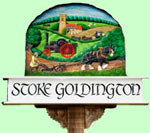STOKE GOLDINGTON’S COACHING HISTORY
In 1830 the small Bucks Parish of Stoke Goldington and Eakley (population then 735) boasted no less than seven inns which provided hospitality and horse changing facilities for stagecoaches and Royal Mail Coaches:
The Bulls Head, Black Dog, Monarch, White Lion, George & Dragon, Coach & Horses and George Inn.

The Royal Mail and Passengers were transported over long distances by horse drawn coaches on a regular scheduled basis.
The coaches, when fully loaded, were very heavy and were pulled by teams of four horses, which had to be changed at regular intervals (about every ten miles).
Progress was around ten miles per hour and so on the journey of 191 miles from Manchester to London the teams had to be changed eighteen times, during the nineteen-hour journey.
Most of the traffic between London and The North (Birmingham, Leeds, Manchester & Liverpool) went via Northampton.
Stoke Goldington is just twelve miles south of Northampton so it was an obvious place for a staging post.
There were about twenty-eight coaches per day travelling through the village hence the need for the seven inns.
Click for routes /timetables
The inhabitants of Stoke Goldington obtained gainful employment from the infrastructure need to support the coach services:- Ostlers; Inn staff; Forage suppliers; Road maintenance crews etc.
The passenger fares charged were 2.5 pennies per mile ’outside’ and 4.5 pennies ’inside’, but with weekly earnings of some 12 shillings the good folk of Stoke Goldington could not afford to travel far in spite of the numerous destinations on offer.
But this was all to change, for a competitor no horse drawn road transport could resist was imminent – the Steam Railway…
The London and Birmingham railway was operating completely by the late 1830’s although, because of continuing work at Kilsby Tunnel and Roade Cutting for a time in 1838, services terminated at Denbigh Hall on the Watling Street just north of Bletchley and a connecting coach shuttle service operated to Rugby where passengers re-boarded the train to Birmingham.
For a time local coaches acted as feeders to the railway but with the Victorian boom most towns soon had railway connections.
By 1840 The Midland Railway had established the line between Euston and Birmingham and The Grand Union Canal between London and Birmingham had opened.
The need for Mail & Stagecoaches soon disappeared. Many coaching Inns became Farm houses (eg George Inn) or Beer Houses
Stoke Goldington reverted back to its rural tranquillity – the author’s great grandmother recalled grass and weeds growing in the highway in the 1890’s.
However history repeated itself with the road transport renaissance of the 20th century. By the 1920’s long distance motor coaches served the village with destinations virtually identical with those of the horse drawn age.
The village became the base of a well known bus and coach operator Wesleys Coaches whose apt slogan “Travel the Wesley Way” was seen far and wide in the United Kingdom and the continent up until the 1980’s.

We are indebted to Andrew Shouler, who researched and transcribed these web pages.
Sources:-
a) Pigot & Company’s “National Commercial Directory 1830”. Reprinted 1975 by Northamptonshire Libraries.
b) Directory of Stagecoach Series 1836 by Alan Bates. Published 1969 by David & Charles.
c) The Geography & Coaching in early 19th century Northants. By D H Kennett – Journal of The Northamptonshire Record Society 1974.
d) London Birmingham – A railway of Consequence. By David Jenkinson – Capital Transport 1988.
